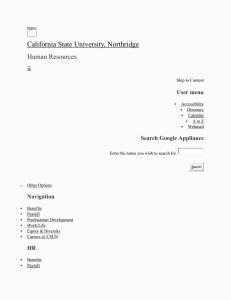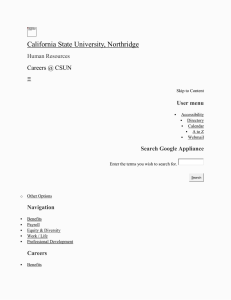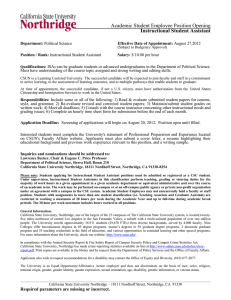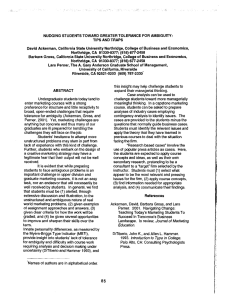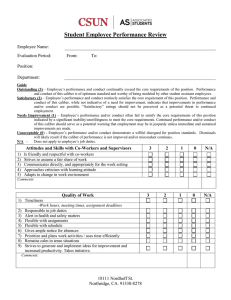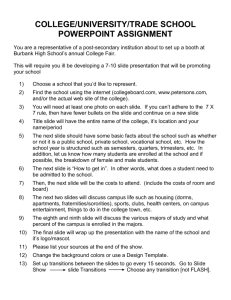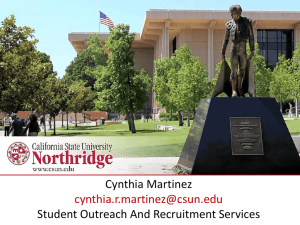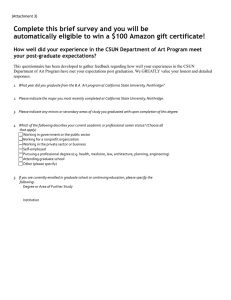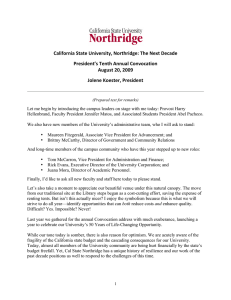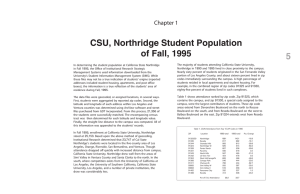Document 14867236
advertisement
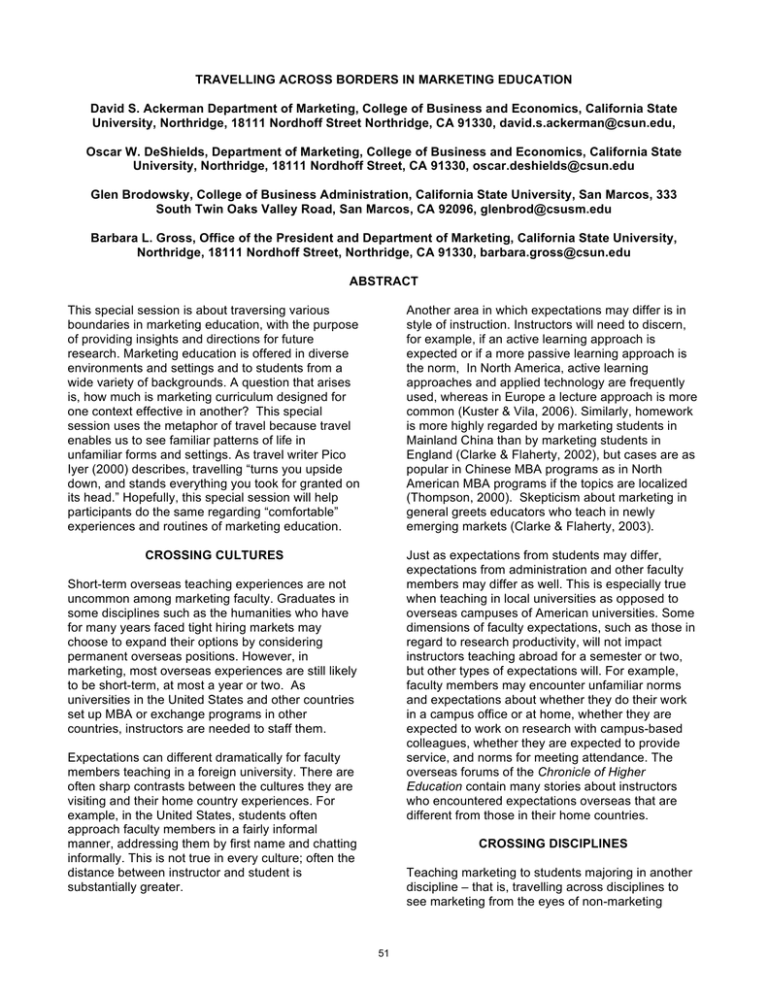
TRAVELLING ACROSS BORDERS IN MARKETING EDUCATION David S. Ackerman Department of Marketing, College of Business and Economics, California State University, Northridge, 18111 Nordhoff Street Northridge, CA 91330, david.s.ackerman@csun.edu, Oscar W. DeShields, Department of Marketing, College of Business and Economics, California State University, Northridge, 18111 Nordhoff Street, CA 91330, oscar.deshields@csun.edu Glen Brodowsky, College of Business Administration, California State University, San Marcos, 333 South Twin Oaks Valley Road, San Marcos, CA 92096, glenbrod@csusm.edu Barbara L. Gross, Office of the President and Department of Marketing, California State University, Northridge, 18111 Nordhoff Street, Northridge, CA 91330, barbara.gross@csun.edu ABSTRACT This special session is about traversing various boundaries in marketing education, with the purpose of providing insights and directions for future research. Marketing education is offered in diverse environments and settings and to students from a wide variety of backgrounds. A question that arises is, how much is marketing curriculum designed for one context effective in another? This special session uses the metaphor of travel because travel enables us to see familiar patterns of life in unfamiliar forms and settings. As travel writer Pico Iyer (2000) describes, travelling “turns you upside down, and stands everything you took for granted on its head.” Hopefully, this special session will help participants do the same regarding “comfortable” experiences and routines of marketing education. Another area in which expectations may differ is in style of instruction. Instructors will need to discern, for example, if an active learning approach is expected or if a more passive learning approach is the norm, In North America, active learning approaches and applied technology are frequently used, whereas in Europe a lecture approach is more common (Kuster & Vila, 2006). Similarly, homework is more highly regarded by marketing students in Mainland China than by marketing students in England (Clarke & Flaherty, 2002), but cases are as popular in Chinese MBA programs as in North American MBA programs if the topics are localized (Thompson, 2000). Skepticism about marketing in general greets educators who teach in newly emerging markets (Clarke & Flaherty, 2003). CROSSING CULTURES Just as expectations from students may differ, expectations from administration and other faculty members may differ as well. This is especially true when teaching in local universities as opposed to overseas campuses of American universities. Some dimensions of faculty expectations, such as those in regard to research productivity, will not impact instructors teaching abroad for a semester or two, but other types of expectations will. For example, faculty members may encounter unfamiliar norms and expectations about whether they do their work in a campus office or at home, whether they are expected to work on research with campus-based colleagues, whether they are expected to provide service, and norms for meeting attendance. The overseas forums of the Chronicle of Higher Education contain many stories about instructors who encountered expectations overseas that are different from those in their home countries. Short-term overseas teaching experiences are not uncommon among marketing faculty. Graduates in some disciplines such as the humanities who have for many years faced tight hiring markets may choose to expand their options by considering permanent overseas positions. However, in marketing, most overseas experiences are still likely to be short-term, at most a year or two. As universities in the United States and other countries set up MBA or exchange programs in other countries, instructors are needed to staff them. Expectations can different dramatically for faculty members teaching in a foreign university. There are often sharp contrasts between the cultures they are visiting and their home country experiences. For example, in the United States, students often approach faculty members in a fairly informal manner, addressing them by first name and chatting informally. This is not true in every culture; often the distance between instructor and student is substantially greater. CROSSING DISCIPLINES Teaching marketing to students majoring in another discipline – that is, travelling across disciplines to see marketing from the eyes of non-marketing 51 students – can be equally challenging. Crossdisciplinary marketing education can occur in different contexts. The first and most familiar setting is in the basic marketing courses within business schools. In many business programs, basic marketing courses are a mandatory part of the curriculum for all students. Large course sections often enroll students from accounting, finance, management, information systems and other business school majors. For these students, the goal of the marketing course is to provide, "a survey of marketing theories and practices so that these students will be able to understand the significance of marketing within an organization” (Godar, 2004). specialized. On the other hand, because they have elected to take a specific course, they are motivated to learn and intend to put the acquired marketing skills and knowledge into action in their chosen field. At the very least they have a desire to gain a basic understanding of marketing. FROM COMMUTERS TO ON-CAMPUS STUDENTS Another border that marketing faculty sometimes cross is that of teaching students who live on campus versus those who are commuters. Surveys suggest that though there may be a different level and type of student engagement among resident versus commuter students, the perceptions of commuting students about their experiences in the classroom are not much different from those who live on campus (Kuh, Gonyea, & Palmer, 2001). Marketing departments do take this goal seriously and write it into course descriptions. For example, the California State University, Northridge University Catalog (2010-2012) describes the basic marketing course as, “an introduction to marketing management's role in an organization's business strategy.” Even though students in other business majors may never directly use marketing skills in their careers, as business majors they need to understand the role of marketing as part of an organization’s strategy and to know how to interact with marketing professionals. There is some evidence of differences in preference for curricular mode. Ping (2007) found for example that nonmarketing students more likely to prefer delivery of marketing curriculum through web-based courses rather than in-class lectures. Nevertheless, commuting students do face some unique challenges. The commuting population often contains higher proportions of first-generation students who bring different cultural expectations and norms and re-entry students and others with working experience and heavy responsibilities beyond campus. Some identify more with offcampus communities than with their peers on campus. Some attempt to fit education into an already full load of responsibilities and commitments. The norms and responsibilities students bring with them can affect their engagement with the campus as a whole (Newbold, Mehta, & Forbus, 2010), but how do they impact classroom performance? How might marketing instruction and curriculum be aligned to be most effective for these students? Some marketing courses such as consumer behavior and various elective courses will include students who are not only outside the marketing major but outside the business school as well. Examples are students in fashion merchandising and consumer sciences who take consumer behavior and retailing courses; journalism, communication, and art students who take an advertising course; students in majors such as music, art, and engineering who take marketing strategy and entrepreneurship courses; and students in the behavioral sciences who take consumer behavior. Many of these students voluntarily choose a marketing course as an elective. In this special session, David Ackerman shared his experiences teaching marketing in the communications school at Chengchi University in Taiwan, an experience which required travelling across all the boundaries discussed above as compared with the environment of his home university. Glen Brodowsky discussed his experiences teaching marketing to business students at the same university, Chengchi University in Taiwan, as well as at the Copenhagen Business School in Denmark. Oscar Deshields and Barbara Gross discussed their experiences with teaching students from outside the business disciplines in advertising, retailing, and consumer behavior courses, as well as thoughts about the rich diversity of students at California State University, Northridge, a large urban public university characterized by diversity on multiple dimensions. These non-business students may have little or no understanding of basic business principles which an instructor preparing the marketing course might reasonably expect of business students. Sometimes, for example, they have never before read an income statement or balance sheet. The needs of such students are different and sometimes very 52
